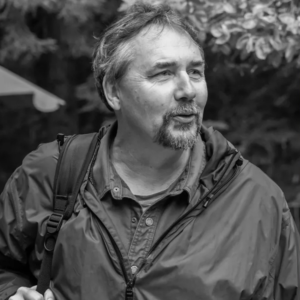“Let me take you on a tour of the end of the world,” David Gessner writes in the first line of his new book, “A Traveler’s Guide to the End of the World: Tales of Fire, Wind, and Water.” Sure, climate end times are depressing to think about, but, Gessner assures the reader, “our journey can still be kind of fun.”
“Not hopeful mind you, that treacherous word I have come to regard warily,” he writes, “but fun … it’s a strange and sloppy world.”
Gessner, an award-winning author who often writes about nature, didn’t set out to write a climate book, he said. But in 2020 and 2021, two places he visited—Boulder, Colorado and Moab—were inundated by wildfires and smoke, and his own home in North Carolina was threatened by hurricanes.
“It was like, the world is telling me something in terms of the subject matter of the next book,” Gessner said.


He realized he wanted to, and felt the need to, write a book about climate change, but he wanted to avoid the common, juxtaposing tropes of hope and doom. Instead, the book is centered around his daughter Hadley, a teenage climate activist heading off to college. Gessner asks, what will the world be like when Hadley is grown up?
Gessner splits the book into four sections: “Where the Arrows Point,” “Empty Houses,” “Hurricane Season,” and “A New World.” He weaves through personal anecdotes (conversations with his daughter), travel stories (he visited the local home of Ken Sleight, soon after Sleight lost his personal archive to the Pack Creek Fire), and conversations with scientists to paint a picture of how climate change may alter—and has already altered—the United States. He visits places including Washington, D.C.; Boulder, Colorado; Torrey, Utah; Topsail Island, North Carolina; and New Orleans, Louisiana.
He uses those personal stories—and dashes of humor—to get readers to pay attention, he said. The issue with discussing climate change is that it can so quickly become depressing. This is not a book with emphatic language, he said—it’s human, like a discussion between friends.
“As a writer, it’s up to you to tell a story as deeply and with as much complexity as you can,” Gessner said. “… One of the themes of the book is repression—it’s understandable that we tamp down and don’t think about something so overwhelming and big. If you really sit there and imagine what the world is going to be like for your kid, it’s not a happy experience. At one point I wanted the book to be this inspiring-anti-climate-change-fight-song, but then it changed to now, if there’s one message of the book, it’s ‘wake up.’”
Gessner said his daughter Hadley, and younger people in general, were a huge inspiration for the book—it seems to him that climate change feels more real for younger generations. In the book, Gessner includes his conversations with Hadley (“doom is normal,” she says when discussing her climate anxiety with her dad).
“What is to be done?” Gessner writes near the end of the book. “Even if I claim I want to sing to, not save, the world, I don’t want this world to go away. I want Hadley to be able to explore the beaches and canyons and forests just as I have. I want her children and their children to be able to do the same.”
By the end of the book, Gessner doesn’t answer that question: instead, he continues to ask it of the reader. The book doesn’t end with policy bullet points, or ideas for doing better—it ends on a non-conclusion, a beginning to a conversation the reader could have with people around them.
“Ending with uncertainty might not be to everyone’s tastes, but to me, it seemed more honest,” Gessner said.
David Gessner will visit Back of Beyond Books on Monday, June 26 at 7 p.m. to read from and present “A Traveler’s Guide to the End of the World.”




